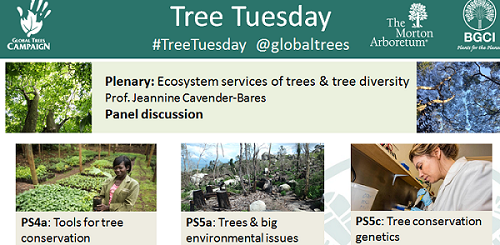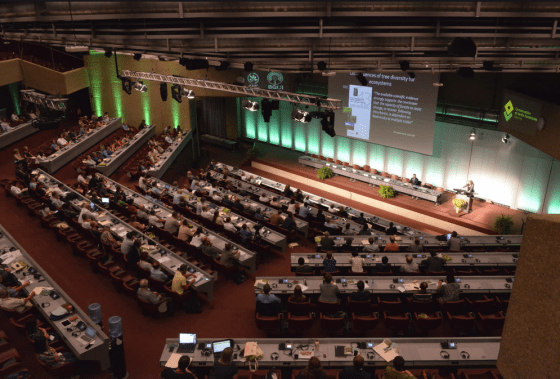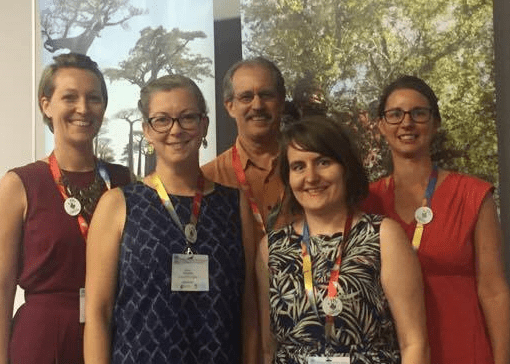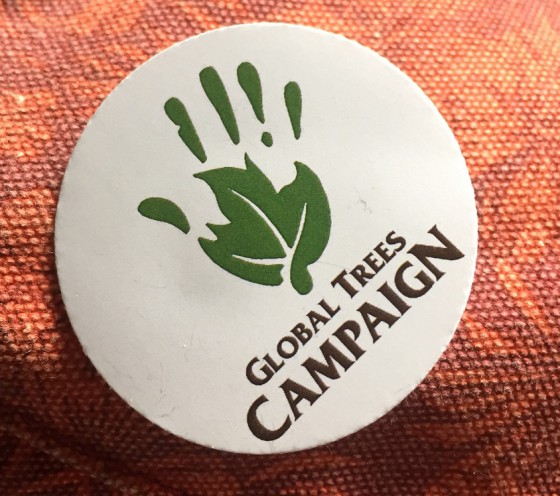
Getting Threatened Trees Trending
To help raise awareness of the plight currently facing the world’s tree species, the GTC organised a suite of tree conservation talks on Tree Tuesday of BGCI’s Sixth Global Botanic Garden Congress to place threatened trees firmly in the limelight. Here Yvette Harvey-Brown reports on the major discussion points of Tree Tuesday.
BGCI’s Sixth Global Botanic Garden Congress (6GBGC) was hosted by the Conservatoire et Jardin botaniques de la Ville de Genève, Switzerland, from the 26th-30th of June 2017. It brought together over 500 delegates from a variety of institutions including botanic gardens, non-governmental organisations (NGO’s), trusts and foundations, universities and government organisations. Talks and roundtable discussions were organised throughout the day to highlight not only GTC achievements but also the conservation challenge ahead, and to emphasise that only through working together in partnership can we achieve GTC’s goal of preventing all tree species extinctions in the wild.
Tree Tuesday was kicked off by an inspiring plenary talk from Jeannine Cavender-Bares, Professor at the University of Minnesota in Ecology, Evolution and Behaviour, about the importance of tree species and the essential role of that botanic gardens play in their conservation. For example by holding threatened tree species in their ex situ collections and using these collections for implementing recovery and restoration programmes. Jeannine also highlighted the essential role that individual tree species play in ecosystems, and thus why tree species diversity needs to be conserved.

Packed audience for Jeannine Cavender-Bares plenary talk on trees. Credit: Mélanie Zogheb/ Conservatoire et Jardin botaniques de la Ville de Genève
New tools for prioritising tree conservation
A major GTC achievement this year was the launch of GlobalTreeSearch, the first comprehensive list of the world’s tree species, and their country level distribution. How GlobalTreeSearch and other tools produced and managed by BGCI can aid tree conservation and in particular contribute to the Global Tree Assessment (GTA), was presented to a full house. A recent gap analysis conducted by BGCI was also presented highlighting that 28% of globally threatened trees are currently held in botanic garden collections but only 27% of these collections are held in the country of origin. Botanic gardens were encouraged to increase native tree species representation within their collections.
Due to the high geographic representation of international delegates present at the Congress, it was the perfect platform to increase participation in the Global Tree Assessment (which aims to Red List all trees by 2020) particularly in areas where there are trees most in need of conservation action. Botanic gardens are ideally placed to contribute to the GTA due to their extensive botanical expertise. Enthusiasm among attendees to be involved with GTA was high and it is hoped that the session will mobilise action to contribute to the GTA and practical tree conservation efforts.
GTC partner, the Morton Arboretum, also promoted their new species prioritisation tool which is currently in development to support conservation decisions and to enable practitioners to focus conservation action where it is needed most. For example if 20 species within a given region are assessed as Critically Endangered on the IUCN Red List, the prioritisation tool can be used to rank these species according to threat level on a scale more precise than the Red List alone and therefore identify which species to focus efforts on first. Keep up to date with the GTC website for more information on this tool later this year.

Members of Team Tree: Kirsty Shaw (BGCI), Murphy Westwood (The Morton Arboretum), George Schatz (Missouri Botanical Garden), Emily Beech (BGCI) and Malin Rivers (BGCI)
Application of genetics in tree conservation
The Morton Arboretum held a session exploring the importance and application of genetics in conservation of threatened tree species. One of the key messages was that seed collections can be made smarter and more efficient by taking into account that not all tree species are the same and utilising species specific knowledge to guide collections. Collecting seed from trees requires more effort that collecting from other plants that are smaller with more accessible seed. The new guidance being developed and presented by geneticists at the conference is helping to ensure tree seed collecting efforts make the most of time and resources and capture a good proportion of genetic diversity.
Progress through partnerships
A key message from the GTC on ‘Tree Tuesday’ was a call to action. We want more groups to work on tree conservation. To share our own experience with developing partnerships, a round table session was held focussing on cross-discipline collaboration for tree conservation. On the panel of this session were representatives from NGO’s, the private sector, the botanic garden sector, a foundation and BGCI. How to establish a successful partnership was discussed as well as the benefits and common challenges to collaborative working. It is hoped that the roundtable will encourage more organisations to set up cross-sectorial partnerships which can bring to the table their own diverse set of skills.
The Morton Arboretum also outlined their ArbNet accreditation program which enables institutions to be recognised for achievement of specified levels of professional practice. The scheme has four levels, with the highest (level IV) requiring the organisation to take an active role in supporting tree conservation through the GTC. This platform also provides an opportunity for botanic gardens to join together to raise their accreditation level. For example, the work of the University of Oxford Botanic Garden and Arboretum to collaborate with Ethiopian botanic gardens and increase their accreditation level was highlighted. By promoting the partnership format it is expected that more organisations with threatened tree collections will develop twinning partnerships, to build capacity for tree conservation. More information on how to get involved with the twinning programme will be released on the BGCI website soon.

Each participant got their very own eco-friendly GTC badge!
Our mission to get threatened trees trending was a big success with botanic gardens approaching GTC staff throughout the rest of the Congress to find out how they can step up their role for tree conservation. Contact us to find out how you can get involved and check out the hashtag #TreeTuesday for photos and highlights from the day.
Tree Tuesday was generously sponsered by The Morton Arboretum
Comments
I must say that BCGI is doing a great job in restoration across the globe, well done.
Please I will like to have a list of threatened trees species that are native to nigeria
I recently discovered Arderne Gardens, a park in Cape Town, and there are a few of the mighty Norfolk Pine there. I didn’t know they were endangered.
Thanks for the work you are all doing. It’s important that people know and understand how significant trees are on the planet and their role here. I would recommend you read the book by Dianne Robbins entitled “Tree Talk”. In it you will discover their purpose. You will find a message from the Redwoods in chapter 15 of the book entitled Telos Vol 1 by Aurelia Louise Jones. This is part of their message to humanity:
“You have so much to learn, my friends, of the “real values” of Life! If our words seem harsh to you, take them as a wake-up call, a plea for compassion for all other Life forms on this planet that are receiving the same harsh treatment from humanity. Ultimately, when you have reached a state of evolution high enough to understand the Eternal Laws of Oneness with all life, you will know that the love and compassion you accord to another, no matter what form it takes, is for your own benefit.”
Just wanted to say keep up the excellent work. Cheers
for the article.